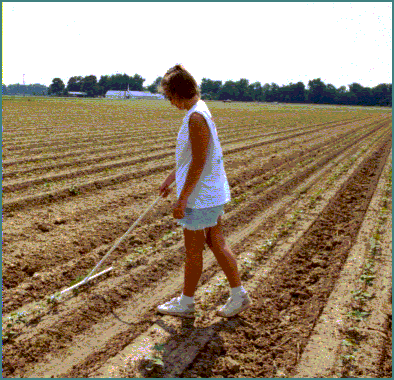Data CollectionCOTMAN requires summary information for each farm/experiment and field/treatment that is monitored. That information is used to set up the program for data collection. The SQUAREMAN component is run pre-flower and the BOLLMAN component is run post first-flower. It is not necessary to run SQUAREMAN in order to run BOLLMAN.
Data can be collected on paper forms or on PDAs.
SQUAREMAN Data:
BOLLMAN Data:
|
|
Sample Site Selection
|
||
Collection Guidelines(View the printable COTMAN Pocket Field Guide) |
||
WHAT data are collected ? |
WHEN is the data collected? |
SAMPLING GUIDELINES |
Stand Density | Once per season after the plant stand is well established |
Use a T-stick to determine # of plants in 3 row feet from 24 consecutive rows.  |
First Fruiting Node (FFN) |
Once per season at the time of the first SquareMap data collection |
Count from the cotyledons (node “0”) up to the first sympodial branch to determine FFN. Record the average FFN on 10 plants at 4 locations in the field |
Plant height, Squaring Nodes, and Square Retention (SquareMap) |
Once or twice per week from the time squares first become visible. Stop collecting SquareMap data when ten plants at a site can be found with a first-position white flower. |
Repeat the following procedure in 4 different locations in each field:
|
Nodes Above White Flower (NAWF) |
Once or twice per week when ten plants at a site can be found with a first-position white flower. Note: When the crop is just starting to flower, you may have to “swim” down the row to find 5 plants with white flowers. Stop collecting BOLLMAN data when the field averages a NAWF value of 5 (cutout) or when latest possible cutout date has been reached. |
Repeat the following procedure in 4 different locations in each field:
|
Weather |
Daily, beginning at cutout and continuing until defoliation. |
Obtain high and low temperatures (°F) from a reliable local source |

